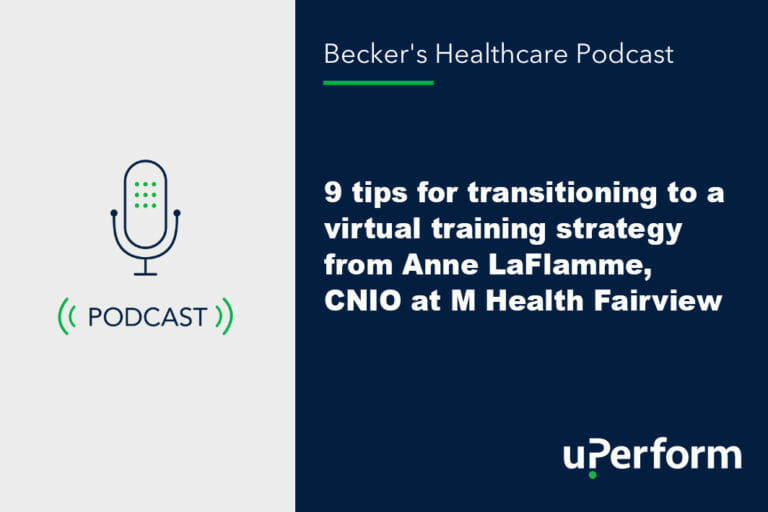One of the biggest challenges facing many training teams is driving end user engagement with training materials and user adoption of new workflows. Change communication emails often go unread, resulting in many clinicians calling their help desk when upgrades and new workflows are pushed live. In a busy hospital setting where patient care takes precedence, communicating changes and delivering training materials at the right place and right time can feel like a shot in the dark.
Community Health Network (CHN), however, may have the answer. The organization has spent the last several years completely revamping its IT Education and communications framework, now leveraging uPerform to deliver change communications and training materials. They made the move from disparate systems to a single source of truth where caregivers can access training and support from their Knowledge+ content library. Now, close to 90% of CHN caregivers are utilizing the Knowledge+ library, and user feedback has been positive.
With a caregiver-first approach, CHN created an environment for education that is nimble yet predictable, and communication comes in many forms to meet the clinicians where they are – from bedside to breakroom.
We sat down with Jennifer Guenin, Manager of IT Training at CHN, in this Becker’s Healthcare podcast episode to learn how she and her team have overhauled their communication and training strategy and what they’ve learned along the way.
Be patient. Be persistent. Think differently.
One of the first things Guenin points out is that change doesn’t happen overnight. Since 2021 CHN has been busy testing different communication methods, and it took time before they saw a significant shift in awareness and utilization of uPerform. Moving to uPerform for communicating changes and delivering training materials was a significant change that impacted thousands of caregivers. Guenin notes that most of these caregivers are focused on patient care, not reading emails. Getting buy-in from leadership and other departments took time and persistence.
To get buy-in, Guenin pushed her team to be persistent and become “a more prominent voice” in their organization. She shares how her team had to explain the why, help people understand the value of a system like uPerform and meet them in ways that helped them answer the question we all ask ourselves: “what’s in it for me?”
For Guenin, that meant addressing the primary needs of the organization:
“The more we can foster a culture of self-service and provide learning within the flow of work, that brings value to people. Caregiver time is the most precious resource we have and shifting towards a culture of making IT training resources easily accessible and digestible is an imperative element that we’re striving for.” — Jennifer Guenin
Through patience and persistence, Guenin and her team helped leadership and other departments at CHN think differently about the opportunities and solutions they had available to them to solve common challenges.
Be a partner to other departments
Guenin touched on selling the idea of a solution like uPerform internally. To do this successfully may require playing the role of a partner for other departments.
“At least temporarily, we traded a system and processes that worked really well for IT in exchange for a solution that prioritized the needs of caregivers. And that required a ton of coordination and technical support from several other teams in IT,” she reflects.
Guenin and her team worked with these other teams to find solutions to the challenges that the change introduced. With creative problem-solving and API add-ons for uPerform, CHN was able to keep its various systems connected and ensure the teams could work together collaboratively.
“The way we’ve been able to integrate uPerform within our existing IT systems here at CHN has proven invaluable in our relationship with our IT colleagues…I’ve seen our Service Center analysts, Epic and ERP analysts also really embrace uPerform as the source of truth.” — Jennifer Guenin
Leading a horse to water
Getting buy-in from leadership and other departments is one thing. Getting users to engage with your content is when the work really begins. But for Guenin and her team, much of it still comes down to patience and persistence.
Establishing a single source of truth
Step one for Guenin and her team was leveraging uPerform to establish a single source of truth. They consolidated all training and help materials into their Knowledge+ library supported by uPerform. Regardless of the communication strategy they use to point users to help content, it all leads back to uPerform. Now, users know exactly where to go when they need support.
“What uPerform provided is that common thread. The source of truth. A central location. So whether it’s two or 20 different communication strategies being deployed, all those channels, all those roads, all lead back to uPerform.” — Jennifer Guenin
Prioritizing caregiver time by meeting users anywhere and everywhere
CHN leverages multiple Epic integrations to make content as easy to find as possible for their end users. These integrations include:
- A launch button in the top right-hand corner of the Epic application
- Integrated links within specific workspaces (i.e., nursing admission, navigators, ED narrators and more)
- A link to the Knowledge+ library in the Epic F1 dashboard
- A bookmarked URL that directs to the Knowledge+ library
- URLs in the ‘toolkit’ of CHN’s intranet site
- Additional APIs that ensure training and support services appear in other relevant locations where people might go to look for training and support
These are just some of the ‘pull’ strategies that Guenin lists as part of their overall communication strategy. However, she also admits that some of their engagement success is the result of ‘forced’ engagement (effectively, a ‘push’ strategy).
She shares that “getting users into uPerform has felt like sowing a million seeds,” and shares some additional ‘push’ strategies the organization is using to reach end users where they commonly get information, including:
- Sending PDFs with links to uPerform
- Printing flyers and ‘potty posters’ outfitted with QR codes to uPerform
- Leveraging newsletters and recurring communications owned by other teams
- Sending messages directly with uPerform’s Change Communication tool
- Making strategic use of broadcast messages within Epic
She also notes that above all these efforts, word of mouth is the most powerful tool of all in directing end users to the Knowledge+ library. Like selling uPerform to leadership and other departments, this means delivering value to end users and collaborating with subject matter experts (SMEs) and other stakeholders to gather feedback on what users are looking for.
Initial feedback on CHN’s uPerform has been very positive. The Knowledge+ library has made training materials easier to access, information is more relevant to user roles and workflows and it “takes the mystery out of where to go to get help.” But Guenin knows that she and her team can’t rest on their laurels.
With high rates of turnover plaguing healthcare and healthcare workers constantly being inundated with information, Guenin and her team need to remain persistent in order to stay relevant. She hopes to continue building on the foundation her team has established and to drive even more “pull” traffic to the Knowledge+ library as they go. As its has been since day one, it will be a practice in both patience and persistence that will continue to challenge her team, the CHN organization and her peers to think differently.
Related Articles
Drive engagement with uPerform just-in-time training
Looking for a more efficient way to deliver training content that end users will actually utilize? uPerform’s just-in-time delivery of training materials puts training materials in the hands of your end users whenever and wherever they need it.
Contact us today to schedule a demo and learn more about how uPerform can integrate with your software applications to deliver the support your users are looking for.




